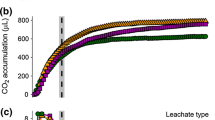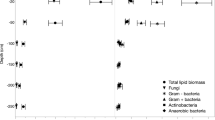Abstract
Biological and physico-chemical characteristics of subglacial sediments were studied in Svalbard. Sediment from close proglacial and supraglacial environments was used for a comparison. Viable bacteria, cyanobacteria and microalgae were detected in subglacial sediments from two polythermal glaciers using epifluorescence microscopy and phospholipid fatty acid (PLFA) analyses. The subglacial samples were generally of higher pH values, coarser texture and lower water content, organic matter, organic carbon, and nitrogen compared to proglacial and supraglacial sediments). Bacterial counts of 1.6 × 107 cells mg− 1 OM (organic matter) were found. Cyanobacteria and algae were also of low abundance [4.2 cells mg− 1 DW (dry weight)]. Cyanobacteria comprised the major proportion of the autophotothrophic assemblages of subglacial soils. Deglaciated soils were similar to subglacial sediment in physico-chemical properties and microbial structure and numbers, unlike soil from vegetated sites or cryoconite sediment. In subglacial and deglaciated soil, relatively low diversity of microorganisms and low substrate availability was detected by PLFA analyses. Good accordance in microbial community structure assessments between epifluorescence microscopy and PLFA analyses was found. Our results suggest that the subglacial microbial populations can be divided into two groups: autochthonous microorganims (chemoheterotrophic bacteria) and allochthonous that retain the ability to proliferate and give rise to active population when conditions become favorable.





Similar content being viewed by others
References
Bloem J, Deruiter PC, Koopman GJ, Lebbink G, Brussaard L (1992) Microbial numbers and activity in dried and rewetted arable soil under integrated and conventional management. Soil Biol Biochem 24:655–665
Bossio DA, Scow KM (1998) Impact of carbon and flooding on soil microbial communities: phospholipid fatty acid profiles and substrate utilization patterns. Microb Ecol 35:265–278
Bottrell SH, Tranter M (2002) Sulphide oxidation under partially anoxic conditions at the bed of the Haut Glacier d’Arolla, Switzerland. Hydrol Process 16:2363–2368
Certini G, Campbell CD, Edwards AC (2004) Rock fragments in soil support a different microbial community from the fine earth. Soil Biol Biochem 36:1119–1128
Christner BC, Mosley-Thompson E, Thompson LG, Reeve JN (2003) Recovery of bacteria from ancient ice. Environ Microbiol 5:433–436
Cockell CS, Rettberg P, Horneck G, Scherer K, Stokes MD (2003) Measurements of microbial protection from ultraviolet radiation in polar terrestrial microhabitats. Polar Biol 26:62–69
Elster J, Kubečková K, Kaštovský J, Kanda H (2000) Algal primary succession on newly deglaciated Arctic moraine, Ny-Ålesund, Svalbard. In: Second international symposium on environmental research in the Arctic. NIPR, Tokyo, Japan
Foght J, Aislabie J, Turner S, Brown CE, Ryburn J, Saul DJ, Lawson W (2004) Culturable bacteria in subglacial sediments and ice from two southern hemisphere glaciers. Microb Ecol 47:329–340
Frostegård Å, Tunlid A, Bååth E (1993) Phospholipid fatty acid composition, biomass, and activity of microbial communities from two soil types experimentally exposed to different heavy metals. Appl Environ Microbiol 59:3605–3617
Gaidos E, Lanoil B, Thorsteinsson T, Graham A, Skidmore M, Han S-K, Rust T, Popp B (2004) A viable microbial community in a subglacial volcanic crater lake, Iceland. Astrobiology 4:327–344
Gilichinsky DA, Wagener S, Vishnivetskaya T (1995) Permafrost microbiology. Permafrost Periglac Process 6:281–291
Hillebrand H, Dürselen C-D, Kirschtel D, Pollingher U, Zohary T (1999) Biovolume calculation for pelagic and benthic microalgae. J Phycol 35:403–424
Hoffman PF, Schrag DP (2002) The snowball Earth hypothesis: testing the limits of global change. Terra Nova 14:129–155
Kaštovská K, Elster J, Stibal M, Šantrůčková H (2005) Microbial assemblages in soil microbial succession after glacial retreat in Svalbard (High Arctic). Microb Ecol 50:396–407
Kirschvink JL, Gaidos EJ, Bertani LE, Beukes NJ, Gutzmer J, Maepa LN, Steinberger RE (2000) Paleoproterozoic snowball Earth: extreme climatic and geochemical global change and its biological consequences. Proc Natl Acad Sci USA 97:1400–1405
Krawczyk WE, Pulina M, Řehák J (1997) Similarity between the hydrologic system of the Werenskiold glacier (SW Spitsbergen) and a karst. In: Proceedings of the international congress of speleology. La-Chaux-de-Fonds, Switzerland, pp 493–496
Marshall WA, Chalmers MO (1997) Airborne dispersal of Antarctic algae and cyanobacteria. Ecography 20:585–594
Mikucki JA, Foreman CM, Sattler B, Lyons WB, Priscu JC (2004) Geomicrobiology of Blood Falls: an iron-rich saline discharge at the terminus of the Taylor Glacier, Antarctica. Aquat Geochem 10:199–220
Nicol GW, Tscherko D, Embley TM, Prosser JI (2005) Primary succession of soil Crenarcheota across a receding glacier foreland. Environ Microbiol 7:337–347
Ohtonen R, Fritze H, Pennanen T, Jumpponen A, Trappe J (1999) Ecosystem properties and microbial community changes in primary succession on a glacier forefront. Oecologia 119:239–246
Oravecz O, Elhottová D, Krištůfek V, Šustr V, Frouz J, Tříska J, Márialigeti K (2004) Application of ARDRA and PLFA analysis in characterizing the bacterial communities of the food, gut and excrement of saprophagous larvae of Penthetria holosericea (Diptera:Bibionidae): a pilot study. Folia Microbiol 49:83–93
Pälli A, Moore JC, Jania J, Kolondra L, Głowacki P (2003) The drainage pattern of Hansbreen and Werenskioldbreen, two polythermal glaciers in Svalbard. Polar Res 22:355–371
Price PB (2000) A habitat for psychrophiles in deep Antarctic ice. Proc Natl Acad Sci USA 97:1247–1251
Priscu JC, Christner BC (2004) Earth’s icy biosphere. In: Bull A (ed) Microbial diversity and bioprospecting. American Society for Microbiology, Washington, DC, pp 130–145
Řehák J, Řehák J Jr, Řehák S (2004) Penetration of subglacial channel systems of Torell and Werenskiold glaciers. In: Proceedings of XIV seminar on polar meteorology and climatology. Marine Academy, Gdynia, Poland
Sharp M, Parkes J, Cragg B, Fairchild IJ, Lamb H, Tranter M (1999) Widespread bacterial populations at glacier beds and their relationship to rock weathering and carbon cycling. Geology 27:107–110
Sigler WV, Zeyer J (2002) Microbial diversity and activity along the forefields of two receding glaciers. Microb Ecol 43:397–407
Sigler WV, Crivii S, Zeyer J (2002) Bacterial success in glacial forefield soils characterized by community structure, activity and opportunistic growth dynamics. Microb Ecol 44:306–316
Skidmore ML, Sharp MJ (1999) Drainage system behaviour of a high-Arctic polythermal glacier. Ann Glaciol 28:209–215
Skidmore ML, Foght JM, Sharp MJ (2000) Microbial life beneath a high Arctic glacier. Appl Environ Microbiol 66:3214–3220
Skidmore M, Anderson SP, Sharp M, Foght J, Lanoil BD (2005) Comparison of microbial community compositions of two subglacial environments reveals a possible role for microbes in chemical weathering processes. Appl Environ Microbiol 71:6986–6997
ter Braak CJF, Šmilauer P (2002) CANOCO reference manual and CanoDraw for Windows user’s guide: software for canonical community ordination (version 4.5). Microcomputer Power, Ithaca, 550 pp
Tranter M, Sharp MJ, Lamb HR, Brown GH, Hubbard BP, Willis IC (2002) Geochemical weathering at the bed of Haut Glacier d’Arolla, Switzerland: a new model. Hydrol Process 16:959–993
Tranter M, Skidmore M, Wadham J (2005) Hydrological controls on microbial communities in subglacial environments. Hydrol Process 19:995–998
Tscherko D, Rustemeier J, Richter A, Wanek W, Kandeler E (2003) Functional diversity of the soil microflora in primary succession across two glacier forelands in the Central Alps. Eur J Soil Sci 54:685–696
Vincent WF, Howard-Williams C (2001) Life on snowball Earth. Science 287:2421
Wadham JL, Hodson AJ, Tranter M, Dowdeswell JA (1998) The hydrochemistry of meltwaters draining a polythermal-based, high Arctic glacier, south Svalbard: I. The ablation season. Hydrol Process 12:1825–1849
Wadham JL, Bottrell S, Tranter M, Raiswell R (2004) Stable isotope evidence for microbial sulphate reduction at the bed of a polythermal high Arctic glacier. Earth Planet Sci Lett 219:341–355
Acknowledgments
This work was supported by the grants GA ASCR B6005409 and Czech Science Foundation 206/03/P024, the Grant Agency of the Ministry of Education of the Czech Republic MSM 600 766 5801 and the EU Commission Grant Quality of Life and Living Resources QLRT-2000-01645 (COBRA). Delegation Fund of the Faculty of Biological Sciences provided financial support for M.S. and M.Š. Members of the IX. Czech glaciospeleological expedition are thanked for help in the field. University of Wrocław kindly enabled us to stay at Baranowski station. Special thanks are due to P. Hrouzek for help with statistical analyses and T. Picek for chemical analyses.
Author information
Authors and Affiliations
Corresponding author
Electronic supplementary material
Rights and permissions
About this article
Cite this article
Kaštovská, K., Stibal, M., Šabacká, M. et al. Microbial community structure and ecology of subglacial sediments in two polythermal Svalbard glaciers characterized by epifluorescence microscopy and PLFA. Polar Biol 30, 277–287 (2007). https://doi.org/10.1007/s00300-006-0181-y
Received:
Revised:
Accepted:
Published:
Issue Date:
DOI: https://doi.org/10.1007/s00300-006-0181-y




